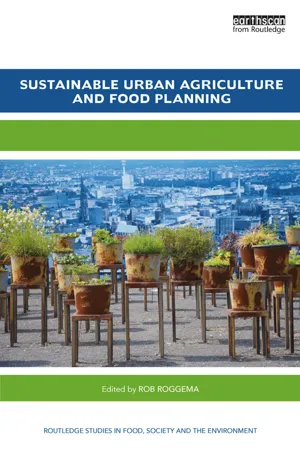
- 272 pages
- English
- ePUB (mobile friendly)
- Available on iOS & Android
Sustainable Urban Agriculture and Food Planning
About this book
As urban populations rise rapidly and concerns about food security increase, interest in urban agriculture has been renewed in both developed and developing countries. This book focuses on the sustainable development of urban agriculture and its relationship to food planning in cities.
It brings together the best revised and updated papers from the Sixth Association of European Schools of Planning (AESOP) conference on Sustainable Food Planning. The main emphasis is on the latest research and thinking on spatial planning and design, showing how urban agriculture provides opportunities to develop and enhance the spatial quality of urban environments. Chapters address various topics such as a new theoretical model for understanding urban agriculture, how urban agriculture contributes to restoring our connections to nature, and the limitations of the garden city concept to food security. Case studies are included from several European countries, including Bulgaria, France, Germany, Italy, Netherlands, Romania, Spain, Turkey and the UK, as well as Australia, Canada, Cameroon, Ethiopia and the United States (New York and Los Angeles).
Frequently asked questions
- Essential is ideal for learners and professionals who enjoy exploring a wide range of subjects. Access the Essential Library with 800,000+ trusted titles and best-sellers across business, personal growth, and the humanities. Includes unlimited reading time and Standard Read Aloud voice.
- Complete: Perfect for advanced learners and researchers needing full, unrestricted access. Unlock 1.4M+ books across hundreds of subjects, including academic and specialized titles. The Complete Plan also includes advanced features like Premium Read Aloud and Research Assistant.
Please note we cannot support devices running on iOS 13 and Android 7 or earlier. Learn more about using the app.
Information
1 Introduction
Introduction
Trends
Thinking at the city region scale
an industry located within (intra-urban) or on the fringe (peri-urban) of a town, an urban centre, a city or metropolis, which grows or raises, processes and distributes a diversity of food and non-food products, reusing mainly human and material resources, products and services found in and around that urban area, and in turn supplying human and material resources, products and services largely to that urban area.(Mougeot, 1999)
| Type | Definition | Scale |
| City region | A more or less concentrated urban centre and its surrounding peri-urban and rural hinterland | Regional landscape |
| Food system planning | Planning of the food system at the urban or the local scale. The system is scalable | Urban region |
| Urban agriculture | Agriculture within (intra-urban) or on the fringe (peri-urban) of a town, an urban centre, a city or metropolis | Urban and peri-urban |
| Urban farming | Farming within and around urban centres | Urban centres |
| Street food | Food sold in a street or other public place | Street, public/private space |
| Street vendor | Person selling food on the pavements or other public/private areas, or mobile | Pavement, public area |
| Community garden | Shared productive land in neighbourhoods, schools, connected to institutions such as hospitals, and on residential housing grounds | Piece of land in neighbourhood |
| Scale | Chapters |
| City region | 3 (Leardini and Serventi), 4 (Van der Valk), 5 (Sanz Sanz et al.), 6 (Keeffe et al.), 14 (Batcha) |
| Food system | 2 (Keeffe), 3 (Leardini and Serventi), 4 (Van der Valk), 6 (Keeffe et al.), 15 (Lee) |
| Urban agriculture | 2 (Keeffe), 7 (Zeunert), 8 (Mylonaki), 11 (Kumru Arapgirlioğlu and Altay Baykan), 12 (Sasso) |
| Urban farming | 2 (Keeffe), 4 (Van der Valk), 9 (Million et al.), 10 (Buchanan) |
| Street food | 16 (Jégou and Carey) |
| Street vendor | 16 (Jégou and Carey) |
| Community garden | 4 (Van der Valk), 13 (Tal Alon Mozes) |
The role of developing countries
Spatial impacts and conditions
Table of contents
- Cover
- Half Title
- Title Page
- Copyright Page
- Table of Contents
- List of illustrations
- Notes on contributors
- 1 Introduction: On the brink of why and how: sustainable urban food planning grows up
- 2 Hardware software interface: a strategy for the design of urban agriculture
- 3 The cultural landscape of food: the infrastructure resilience of Via Emilia
- 4 Foodscape gastropolis New York City
- 5 Peri-urban farmland characterisation: a methodological proposal for urban planning
- 6 Garden cities: a flawed model for ecological urbanism?
- 7 Urban agriculture up-scaled: economically and socially productive public green space
- 8 Urban agri-tecture: the natural way of smart living
- 9 Urban waters for urban agriculture: ROOF WATER-FARMs as participatory and multifunctional infrastructures
- 10 Associating agriculture with education and recreation in Queens, New York
- 11 Urban agriculture as a tool for sustainable urban transformation: Atatürk Forest Farm, Ankara
- 12 Elevating urban agriculture and city resilience: making the case in the City of Los Angeles
- 13 The role of place, community and values in contemporary Israel’s urban agriculture
- 14 Population dimensions, land use change and food security in the peri-urban area of Santa-Babadjou, Western Highlands, Cameroon
- 15 UK farming entrepreneurship for food security in an uncertain future
- 16 Experiences of ten European cities collaborating toward sustainable food governance in an URBACT network
- Index